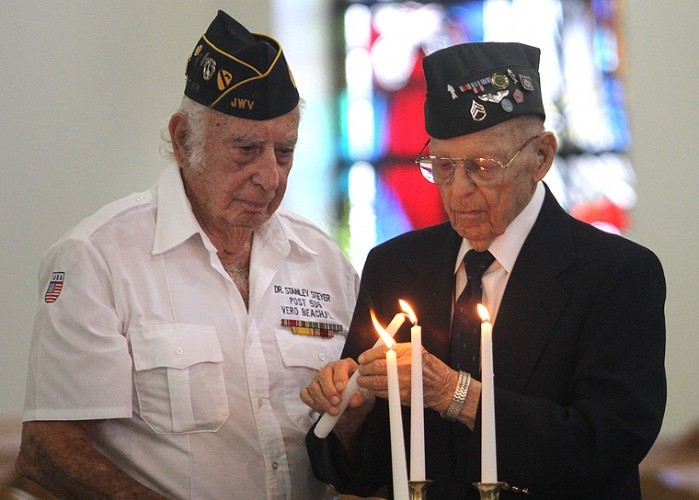
SEBASTIAN — The four chaplains aboard the USAT Dorchester represented three faiths working together as one in the face of imminent danger during World War II; their actions remembered 69 years later at an interfaith ceremony in Sebastian.
The men gave up their lifejackets to four others when the Dorchester began to sink in the frigid waters off Greenland, struck by a German U-Boat’s torpedo on Feb. 3, 1943. The chaplains helped men into life boats, tended to the injured and offered words of comfort as they went down with the ship.
“Their very presence was solace”, said Sebastian City Councilwoman Andrea Coy, Master Sergeant (Ret. Army), during the ceremony.
One by one, the chaplains were remembered during the ceremony at St. Sebastian Catholic Church – Chaplain George Fox, Protestant; Chaplain Alexander Goode, Jewish; Chaplain Clark Poling, Dutch Reformed; and Chaplain John Washington, Roman Catholic – each represented by a clergy member and a lit candle.
The USAT Dorchester was not a battle ship but a transporter, according to historian and US Navy Armed Guard veteran Clarence Korker. It was carrying 751 passengers, 130 crew members and 23 US Navy Armed Guards along with lumber, mail and packages.
The passengers included Danish civilians, members of the US Army and those from the US Coast Guard.
Only 229 people survived the torpedo strike. Issues with the life boats and a lack of life jackets contributed to the casualties. The icy waters, too, claimed others as they waited nine hours for rescue.
Coy described the scene to the crowd of more than 100. The boat entered what had become known as “Torpedo Junction.” Everyone was ordered to where a life jacket and, if possible, to be above board.
The torpedo struck the electrical unit of the ship, releasing steam and ammonia gas, killing many instantly.
The escort vessels traveling with the Dorchester were unaware. Orders were to not use flares or other communication. The ships continued on their course, leaving the sinking ship behind.
Witness accounts, including that of survivor then-Staff Sergeant Ernie Heaton, state the chaplains gave up their lifejackets to four others, stood together with their arms interlocked and went down with the ship singing or praying.
“It was a heroic act of self-sacrifice,” Coy said.
Heaton, who turns 89 next month, was called up during the ceremony to give his now-unclassified testimony of the Four Chaplains. Up until recently, his official statement had remained classified by the US Government.
Heaton was plucked out of the water some nine hours after the ship sank. He had been clinging to a lifeboat, his arm pinned to the inside of the boat by a fellow soldier lucky enough to have gotten a seat.
Heaton gave his testimony on Sept. 6, 1944, more than a year after the attack.
“I witnessed the act of heroism on the part of the Four Chaplains,” he said, explaining he had left his stateroom and went up to the deck. He saw the chaplains give up their jackets and as the ship went down, so, too, did they.
Heaton thanked the crowd for coming out to remember the chaplains and their sacrifice and as he left the stage, the audience gave him a standing ovation.
The ceremony, held every year, will tie into another ceremony being held on Feb. 14 at Riverview Park in Sebastian.
Larry Wapnick, president of the Four Chaplains Monument Committee, is holding a dedication ceremony at the site where the monument will be constructed. The date was selected because it is Heaton’s birthday.
According to Wapnick, the monument symbolizes more than the four men who inspired it – it represents interfaith in action.
“It’s a monument about love and caring,” Wapnick said.
The dedication will be held at the Memorial Park next to the Splash Pad at Riverview Park at 2 p.m. It is open to the public.



